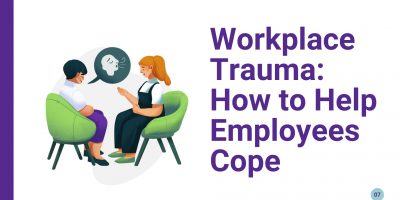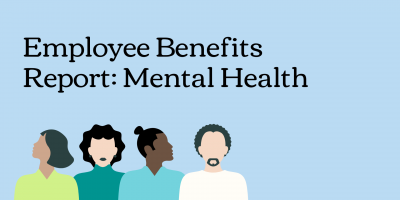
Workplace Trauma: How to Help Employees Cope
Learn to recognize workplace trauma early on, address it correctly, and support struggling employees throughout their emotional recovery.

Substance abuse is a significant problem in society and can have severe implications in the workplace. The effects of substance abuse in the workplace can be wide-ranging and devastating.
From decreased productivity, causing employees to display erratic behavior, or even engaging in criminal activity, inappropriate use of drugs or alcohol can cause many problems for employers.
In fact, the cost of substance use disorders (SUD) is relatively high. Companies lose about $207 billion in indirect productivity loss due to SUDs. 89% of the costs are driven by health-related categories, whereas 11% are crime-related. On a national level, the cost of SUD in the US is approximately $3.73 trillion annually.
Thus, recognizing signs of substance abuse among employees should be made a priority by employers so that effective measures can be put into place before it causes significant damage within their organization.
Substance abuse is the use of any substance that can worsen someone’s decision-making, cognition, or functioning. The use of alcohol or drugs at work, especially during breaks and lunch, as well as being intoxicated or high before or after work are all examples of workplace substance abuse.
The abuse of alcohol and controlled substances are how most businesses describe substance addiction. Yet, it can also include lawfully obtained pharmaceuticals like prescriptions, over-the-counter painkillers, and diet pills.
To adequately identify signs of substance abuse in the workplace, employers must be aware of the types of behaviors to look out for.
Training HR professionals and managers on how to identify substance abuse in the workplace is good practice. Additionally, it is as vital that managers and leaders are also aware of the effects of substance abuse to address it adequately and maintain workplace safety.
Apart from that, random and periodic drug and alcohol testing is a standard method to identify workers who abuse substances. It is also an efficient way to discourage the abuse of substances in the workplace.
Drug testing procedures must comply with local, state, and federal laws. Therefore, employers understand all the regulations regarding drug testing to protect the company and its employees.

Additionally, it is essential to establish a program for drug testing at work. The steps to establishing one vary by industry, job positions, and government regulations. Once it’s written down, the program should be distributed to the whole staff.
Employers must respond quickly if they suspect an employee may be struggling with substance abuse issues. Therefore, they must have an established substance abuse policy outlining the consequences of testing positive and offering support for workers with SUD.
The signs of substance abuse in the workplace can be both physical and behavioral.
The physical signs include:
However, it’s almost impossible to rely entirely on physical manifestations when identifying workers that suffer from SUD.
Behaviors at work are also significant indicators in determining whether employees use drugs or deal with alcoholism. The following are some of the most common behavioral signs of substance abuse.
Employees who abuse drugs and alcohol are often unable to go to work. Therefore, they call in sick more often than others.
According to the National Safety Council (NSC), workers with SUD miss two more weeks than their peers, or an average of 25 days per year. They are more likely to take time off for reasons other than vacation.
Workers who misuse substances become less productive and efficient. In fact, 42% out of the 70% of workers who engage in substance use but remain employed report being less productive due to their usage.
According to the National Institute on Drug Abuse, drugs and alcohol interact with the brain, leading to mood swings and unpredictable behaviors.
Even when the effects begin to fade, the withdrawal creates a psychological reaction in the nervous system leading to anxiety, depression, and irritability.
Employees with SUDs are at a greater risk of developing one or more conditions or chronic diseases. According to a National Institute on Drug Abuse research, addiction and HIV/AIDS are intertwined. Moreover, those with addiction often have one or more associated health issues, including cardiovascular diseases, cancer, stroke, or lung disease.
They often suffer from some kind of mental illness, and this coexistence is known as a co-occurring disorder. SAMHSA’s National Survey on Drug Use and Health found that about 9.2 million American adults have a co-occurring disorder.
Employees’ social wellbeing in the workplace can be affected by their misuse of drugs and alcohol. Since mood swings are a side effect of addiction, , employees under the influence can often come into conflict with their colleagues, managers, and even customers.
The cost of substances for daily use can be high. Therefore, employees who are using are always in need of money through various sources of funding, such as asking about paycheck advances and raises, borrowing, applying for short-term loans, or taking an early withdrawal from 401k.
Unfortunately, some addicts may even steal from work to support their drug and alcohol use. In fact, according to estimates, about 80% of employees steal from their place of work to fund their addictions.
The most common examples of workplace theft don’t only include stealing physical cash but also inventory, equipment, merchandise, or materials.
The cost of substance abuse in the workplace is immense and can have far-reaching effects on an organization.
Researchers estimate that SUDs cost employers roughly $81 billion annually. $25.5 billion is lost due to decreased productivity and increased absenteeism. An additional $25 billion is spent on healthcare costs associated with substance abuse.
According to research by NORC and NSC, employers spend an average of almost $9,000 on each worker with an untreated SUD.
The analysis found that the average employer pays $4,770 in health insurance premiums for employees with SUDs.
However, in many cases, employer-initiated addition treatments are shown to be successful workplace-supported recovery programs.
Therefore, if they support those with SUDs, companies can save over $8,500 for each worker who goes through rehab.
The insurance premiums for workers in recovery stand at $3,961, and recovering addicts take only eight days off annually. Moreover, they have fewer primary care visits and are less likely to be hospitalized, thus reducing healthcare costs for employers.

The effects of substance abuse in the workplace can be extensive and harmful.
However, by showing respect, offering support, and providing resources such as addiction treatment services and EAP providers, companies can reduce the costs associated with SUDs among their workforce.
Ultimately this will lead to happier, healthier workplaces where everyone feels comfortable speaking up if they need help with SUDs instead of being fearful about repercussions due to negative stigmas often associated with substance abuse.
Content Writer at Shortlister
Browse our curated list of vendors to find the best solution for your needs.
Subscribe to our newsletter for the latest trends, expert tips, and workplace insights!

Learn to recognize workplace trauma early on, address it correctly, and support struggling employees throughout their emotional recovery.

Amid rising chaos, nearly half of all Americans face mental health challenges—how are businesses stepping up to meet the growing demand for support?

How important is building relationships and social wellbeing to our health? Do social connections translate to a more satisfying and productive work experience?

Gain a comprehensive understanding of current trends, challenges, and innovative approaches to support mental well-being in today’s fast-paced work environments.
Used by most of the top employee benefits consultants in the US, Shortlister is where you can find, research and select HR and benefits vendors for your clients.
Shortlister helps you reach your ideal prospects. Claim your free account to control your message and receive employer, consultant and health plan leads.